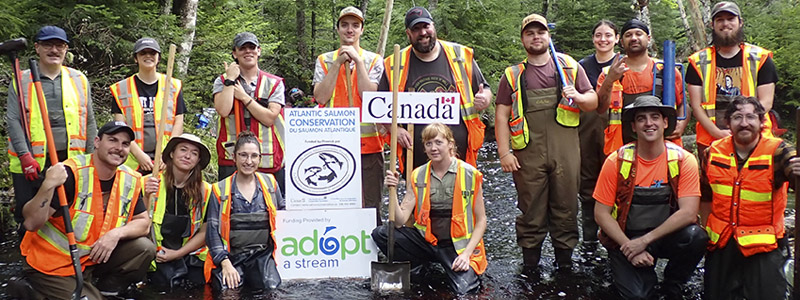Featured Projects
Bluenose Coastal Action Foundation / Nova Scotia / 2023
Restoring connectivity for Atlantic salmon in the LaHave River Watershed

Since 2015 the Bluenose Coastal Action Foundation (BCAF) has been assessing aquatic connectivity in the watershed in waves. This process involved venturing into the watershed, identifying high priority sites based on the amount of upstream habitat available, what species they expected to find, the overall importance of assessing barriers and moving forward with measures to improve fish passage. Improving conditions for Atlantic salmon has always been a particular focus.
“We try to increase the amount of habitat they can access, especially suitable habitat, which we sometimes assess through habitat suitability index assessments to see how much of the upstream habitat is suitable for salmon and exactly how suitable it is,” said Sam Reeves, watersheds & water quality project coordinator for BCAF. “That way we can prioritize our efforts to make sure they’re having the most impact for Atlantic salmon recovery.”
That’s only part of the work that the BCAF does in the watershed. They also add their aquatic connectivity info to databases and sub-watershed fish habitat restoration plans, updating those plans with fresh data as they work at sites to address fish passages and other issues. They also take care to map out locations where invasive species are found, such as smallmouth bass and chain pickerel, to ensure that they are not increasing access for those species. To support their efforts in 2023, the BCAF applied to the FCAS and received a grant for $12,300.
“We have three main activities for the summer,” said Reeves. “The aquatic connectivity work, instream fish habitat improvement work and then we try to do as much education throughout the year as we can. Regarding the aquatic connectivity stuff, between all the fieldwork – like going out and checking on structure and assessing new structures and updating all the databases – we work on that periodically from April right until November. The actual installations are usually done in July, August and September.”
Much of the BCAF’s efforts are long-term ongoing projects – they have been working to address connectivity issues for Atlantic salmon for several years now and expect to continue the work for many more to come.
“We plan to continue to focus in on that key salmon habitat, and we make sure that’s where most of our resources and funding is going,” said Reeves. “We want to have the biggest impact on salmon that we can. And, for example, we’ve started to also focus in on single watercourses where we’ve identified the presence of salmon. The goal was to cover as big of an area as you can, versus just doing smaller improvement in multiple locations. We’re really trying to focus on these key tributaries and watercourses and have the biggest impact we can there.”
